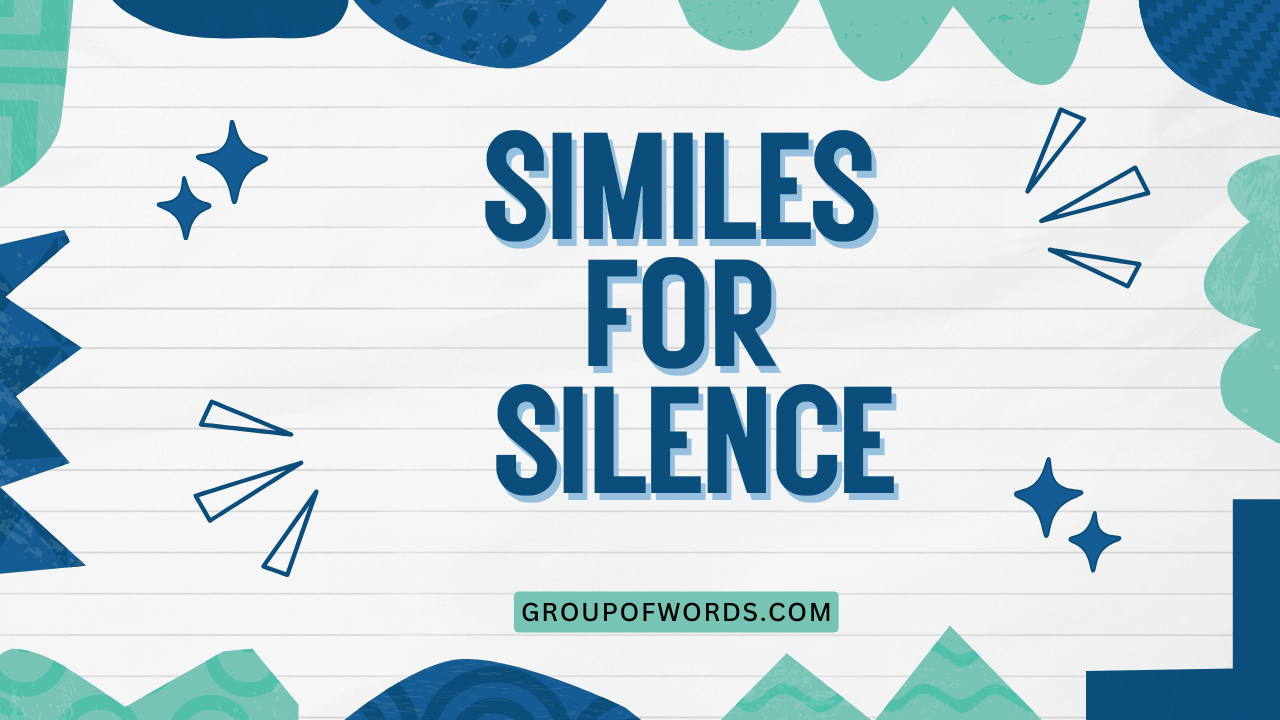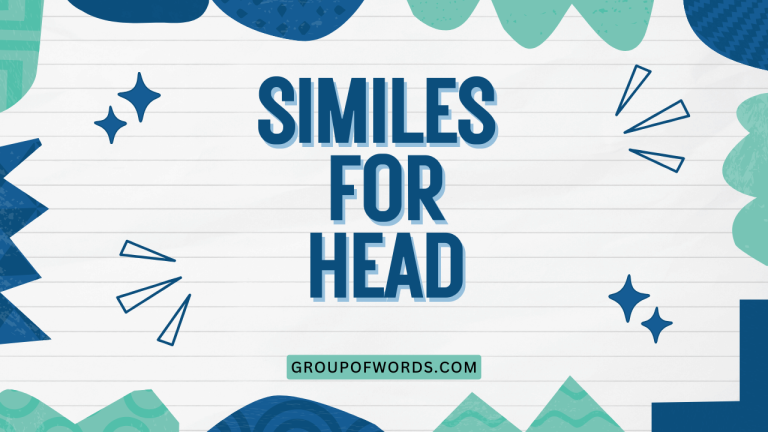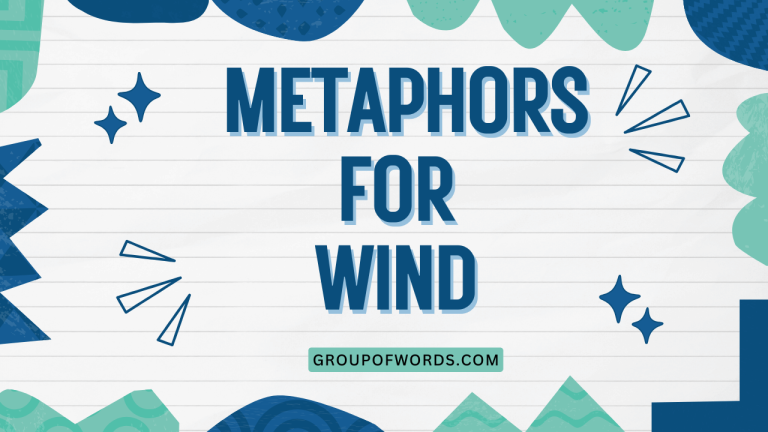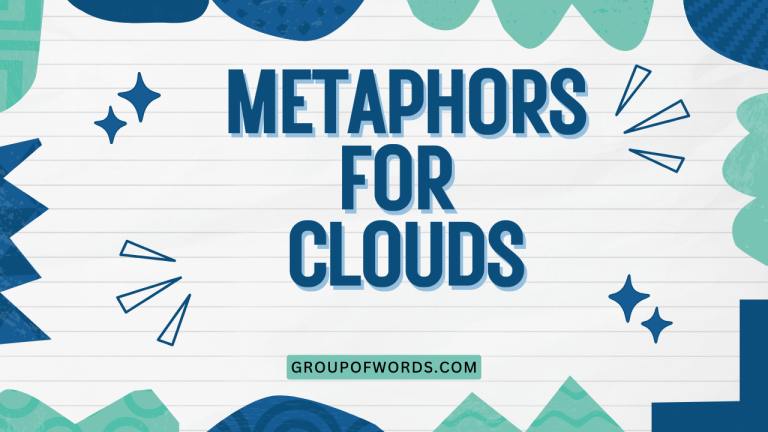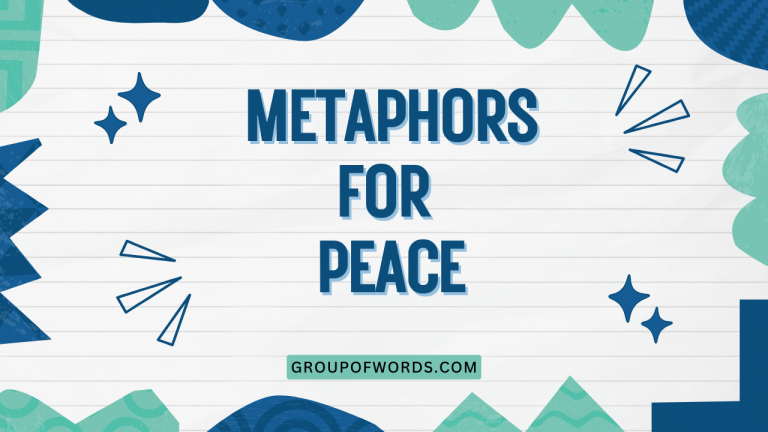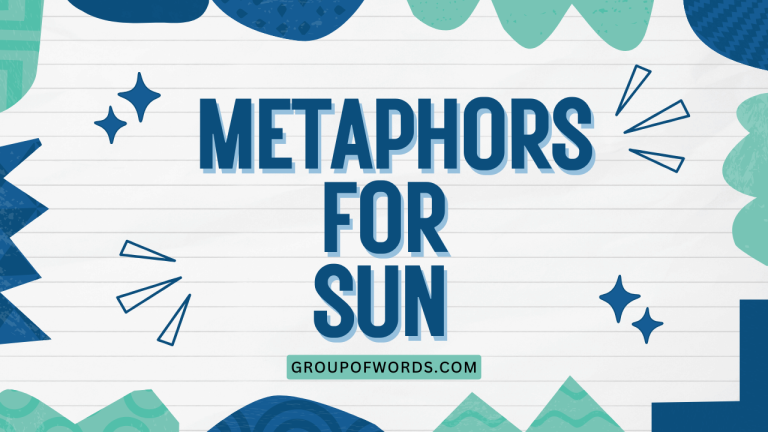Similes for Silence: A Comprehensive Guide
Silence, often perceived as the absence of sound, is a powerful concept with diverse meanings. In the English language, we use similes to paint vivid pictures of silence, comparing it to other things that evoke a similar sense of quietude, stillness, or absence.
Understanding these similes enhances our descriptive abilities, allowing us to convey nuanced meanings and create more impactful imagery. This article provides a comprehensive exploration of similes for silence, covering their definition, structure, types, usage rules, common mistakes, and practice exercises.
Whether you are a student, writer, or language enthusiast, this guide will equip you with the knowledge and tools to effectively use similes to describe silence in your writing and speech.
Table of Contents
- Introduction
- Definition of Similes for Silence
- Structural Breakdown of Similes
- Types of Similes for Silence
- Examples of Similes for Silence
- Usage Rules for Similes
- Common Mistakes with Similes
- Practice Exercises
- Advanced Topics: Metaphor vs. Simile
- Frequently Asked Questions (FAQ)
- Conclusion
Definition of Similes for Silence
A simile is a figure of speech that compares two unlike things using the words “like” or “as.” Similes for silence, therefore, draw parallels between silence and other concepts or objects that evoke a similar feeling of quiet, stillness, or absence of sound. These similes help to create a more vivid and relatable understanding of the silence being described.
The power of a simile lies in its ability to transfer the qualities of one thing (the vehicle) to another (the tenor), enriching the reader’s or listener’s experience. They are a fundamental tool in descriptive writing and figurative language, making abstract concepts more tangible and understandable.
The primary function of a simile for silence is to provide a more descriptive and evocative understanding of the silence in question. Instead of simply stating that something is silent, a simile allows you to convey the type of silence, its intensity, and its emotional impact. For instance, “silence like a tomb” conveys a very different feeling than “silence like a gentle snowfall.” Similes help to paint a picture in the reader’s mind, making the description more engaging and memorable. They also add depth and complexity to writing, making it more sophisticated and interesting.
Similes for silence can be used in a variety of contexts, including literature, poetry, everyday conversation, and technical writing. In literature and poetry, they are often used to create atmosphere, develop character, and explore themes.
In everyday conversation, they can be used to add emphasis or humor. Even in technical writing, similes can be used to explain complex concepts in a more accessible way.
The key is to choose a simile that is appropriate for the context and audience.
Structural Breakdown of Similes
The basic structure of a simile consists of three main components: the tenor, the vehicle, and the connective word (either “like” or “as”). The tenor is the subject being described (in this case, silence). The vehicle is the object or concept to which the tenor is being compared. The connective word explicitly establishes the comparison between the two.
Let’s break down an example: “The silence was like a thick blanket.”
- Tenor: The silence
- Connective Word: like
- Vehicle: a thick blanket
In this example, the silence (tenor) is being compared to a thick blanket (vehicle) using the word “like” (connective word). The comparison suggests that the silence was heavy, enveloping, and perhaps even comforting, similar to how a thick blanket feels.
The effectiveness of the simile lies in the reader’s ability to relate to the feeling of being wrapped in a thick blanket and then transferring that feeling to the silence being described.
Another example using “as”: “The night was as silent as a grave.”
- Tenor: The night
- Connective Word: as
- Vehicle: a grave
Here, the night (tenor) is being compared to a grave (vehicle) using the word “as” (connective word). This simile evokes a sense of stillness, death, and perhaps even unease, suggesting that the night was profoundly quiet and still.
The choice of “grave” as the vehicle creates a darker and more somber tone than the previous example.
Understanding the structural components of a simile allows you to create your own effective similes for silence. By carefully selecting the vehicle and using the appropriate connective word, you can craft similes that accurately and evocatively convey the specific type of silence you wish to describe.
Consider the qualities of the silence you want to portray and then choose a vehicle that shares similar qualities.
Types of Similes for Silence
Similes for silence can be categorized based on the type of silence they describe and the emotions they evoke. Here are some common categories:
Absolute Silence
These similes describe a complete absence of sound, often emphasizing the stillness and emptiness of the environment. They often involve comparisons to things that are naturally quiet or have been silenced.
Peaceful Silence
These similes evoke a sense of tranquility and serenity. They often compare silence to things that are calming and relaxing, such as nature or meditation.
Ominous Silence
These similes create a feeling of unease and foreboding. They often compare silence to things that are associated with danger, fear, or the unknown.
Awkward Silence
These similes describe the uncomfortable and tense silence that occurs in social situations. They often compare silence to things that are strained or unnatural.
Deafening Silence
This is a type of oxymoron which describes a silence that is so intense it feels overwhelming and almost painful. They emphasize the expectation of sound that is not present.
Examples of Similes for Silence
This section provides a wide range of examples of similes for silence, organized by the categories discussed above. Each example is intended to illustrate the different ways in which similes can be used to describe silence and evoke specific emotions.
Similes for Absolute Silence
These examples illustrate similes used to describe complete and total silence. They emphasize the absence of any sound whatsoever and can create a feeling of emptiness or isolation.
The following table provides examples of similes that describe absolute silence. The similes highlight the complete lack of sound and the stillness that accompanies it.
These examples are useful for creating a sense of emptiness or emphasizing the profound quiet of a particular environment.
| Simile | Explanation |
|---|---|
| Silence like a vacuum. | Emphasizes the complete absence of air and, therefore, sound. |
| Silence as deep as space. | Compares the silence to the vast emptiness of outer space. |
| Silence like the grave. | Suggests the stillness and quiet associated with death. |
| Silence as still as a statue. | Compares the silence to the immobility and quiet of a statue. |
| Silence like a closed book. | Implies that there are no words or sounds to be heard. |
| Silence as empty as a deserted house. | Suggests the absence of life and activity. |
| Silence like a frozen lake. | Implicates unmoving, untouched quiet. |
| Silence as hollow as a drum. | Suggests that while something could make noise, it is not. |
| Silence like a world without birds. | A world where the sound of nature is absent. |
| Silence as unbroken as a mirror. | Undisturbed and reflecting nothing. |
| Silence like the eye of a hurricane. | A pocket of stillness surrounded by chaos. |
| Silence as profound as a dream. | A quiet that takes you to another place. |
| Silence like a forgotten song. | No longer remembered or sung. |
| Silence as complete as a full stop. | Marking an end to all sound. |
| Silence like dust after an explosion. | The aftermath of something loud, now quiet. |
| Silence as absolute as zero. | The mathematical representation of nothingness. |
| Silence like a library after hours. | When the books are closed and the readers are gone. |
| Silence as clean as a whistle. | Completely free from noise. |
| Silence like the void before creation. | The emptiness before the universe began. |
| Silence as permanent as a shadow. | Always there, lurking in the background. |
| Silence like the center of the earth. | Deep, unyielding, and remote. |
| Silence as final as a period at the end of a sentence. | A concluding and definitive quiet. |
| Silence like a mime’s performance. | Deliberately avoiding any sound. |
| Silence as deep as an ocean trench. | A place where sound cannot easily travel. |
Similes for Peaceful Silence
These examples illustrate similes that evoke a sense of calm and tranquility. They compare silence to things that are relaxing and soothing, creating a feeling of peace and serenity.
The following table provides examples of similes that describe peaceful silence. These similes emphasize the calming and soothing aspects of silence.
They use comparisons to nature and other tranquil settings to evoke a sense of peace and serenity.
| Simile | Explanation |
|---|---|
| Silence like a gentle snowfall. | Suggests the soft, quiet descent of snow and the peacefulness it brings. |
| Silence as soft as a whisper. | Compares the silence to the barely audible sound of a whisper. |
| Silence like a still pond. | Evokes the image of a calm, undisturbed body of water. |
| Silence as quiet as a sleeping baby. | Compares the silence to the peacefulness of a sleeping infant. |
| Silence like a summer night. | Suggests the warm, quiet stillness of a summer evening. |
| Silence as smooth as silk. | Implies that the silence is pleasant and comforting. |
| Silence like the hush of dawn. | The quiet before the world awakens. |
| Silence as serene as a mountain lake. | Calm and reflective, untouched by the world. |
| Silence like a meditation retreat. | Purposefully seeking quiet for inner peace. |
| Silence as comforting as a warm blanket. | Wrapping you in a sense of security. |
| Silence like the inside of a bubble. | Isolated and protected from the noise of the world. |
| Silence as gentle as a feather falling. | Light and barely perceptible. |
| Silence like a walk in the woods. | Surrounded by nature’s quiet sounds. |
| Silence as deep as a sigh of relief. | Releasing tension and stress. |
| Silence like the lull after a storm. | The peacefulness that follows chaos. |
| Silence as pure as morning dew. | Fresh and untouched. |
| Silence like a secret kept safe. | Guarded and undisturbed. |
| Silence as untroubled as a clear sky. | Free from any disturbances. |
| Silence like a monastery at prayer time. | Devout and reverent. |
| Silence as light as a cloud drifting by. | Floating effortlessly and peacefully. |
| Silence like the moment before sleep. | Drifting into unconsciousness. |
| Silence as warm as a sunbeam. | Comforting and gentle. |
| Silence like the soft glow of candlelight. | Subtle and calming. |
Similes for Ominous Silence
These examples illustrate similes that create a sense of unease and foreboding. They compare silence to things that are associated with danger, fear, or the unknown, creating a feeling of suspense and anticipation.
The following table provides examples of similes that describe ominous silence. These similes emphasize the unsettling and foreboding aspects of silence.
They use comparisons to things that evoke fear or uncertainty to create a sense of unease and anticipation.
| Simile | Explanation |
|---|---|
| Silence like the calm before the storm. | Suggests that something bad is about to happen. |
| Silence as heavy as a guilty conscience. | Compares the silence to the weight of guilt. |
| Silence like a predator stalking its prey. | Evokes a sense of danger and anticipation. |
| Silence as thick as a shroud. | Compares the silence to the cloth used to cover a dead body. |
| Silence like the ticking of a bomb. | Suggests that something explosive is about to occur. |
| Silence as cold as a tombstone. | Implies that the silence is lifeless and unforgiving. |
| Silence like the darkness before dawn. | Hides unknown possibilities. |
| Silence as deep as a bottomless pit. | Threatening and unfillable. |
| Silence like a held breath. | Waiting for something to happen. |
| Silence as watchful as a gargoyle. | Ominous and ever-present. |
| Silence like a room full of secrets. | Hiding something unknown. |
| Silence as sharp as a knife’s edge. | Cutting and tense. |
| Silence like a spider waiting in its web. | Prepared to ensnare its victims. |
| Silence as suffocating as a nightmare. | Oppressive and inescapable. |
| Silence like a ghost in the attic. | Haunting and disturbing. |
| Silence as unnerving as a ventriloquist dummy. | Unnatural and unsettling. |
| Silence like a loaded gun. | Ready to be unleashed. |
| Silence as potent as poison. | Quietly destructive. |
| Silence like a lie left unspoken. | Hiding the truth. |
| Silence as impenetrable as a fortress wall. | Blocking out communication. |
| Silence like the eye of a hurricane. | A deceptive stillness before destruction. |
| Silence as deep as a well. | Hiding secrets and mysteries. |
| Silence like a broken promise. | Leaving a void and disappointment. |
Similes for Awkward Silence
These examples illustrate similes that describe the uncomfortable and tense silence that occurs in social situations. They compare silence to things that are strained or unnatural, creating a feeling of unease and discomfort.
The following table provides examples of similes that describe awkward silence. These similes emphasize the discomfort and tension associated with social silences.
They use comparisons to strained or unnatural situations to evoke a sense of unease and awkwardness.
| Simile | Explanation |
|---|---|
| Silence like a record skipping. | Suggests something has gone wrong and the conversation is stuck. |
| Silence as stiff as a board. | Compares the silence to the rigidity and discomfort of a stiff board. |
| Silence like a dropped conversation. | Evokes the feeling of an unfinished or abruptly ended discussion. |
| Silence as heavy as unspoken words. | Compares the silence to the weight of things left unsaid. |
| Silence like a stalled engine. | Suggests that the conversation has lost momentum and stopped. |
| Silence as strained as a forced smile. | Implies that the silence is unnatural and uncomfortable. |
| Silence like a bad joke falling flat. | Uncomfortable and unwelcome. |
| Silence as thick as pea soup. | Dense and difficult to break through. |
| Silence like a broken telephone line. | Communication cut off. |
| Silence as loud as a scream inside. | The unspoken tension is palpable. |
| Silence like an uninvited guest. | Unwanted and creating discomfort. |
| Silence as prickly as a cactus. | Uncomfortable to touch or engage with. |
| Silence like a forgotten name. | Frustrating and embarrassing. |
| Silence as brittle as thin ice. | Easily broken by the wrong word. |
| Silence like a room with all the lights off. | Dark and unsettling. |
| Silence as awkward as meeting an ex. | Full of unspoken history and tension. |
| Silence like a missed high-five. | Uncoordinated and embarrassing. |
| Silence as tense as a pulled rubber band. | Ready to snap at any moment. |
| Silence like a half-finished sentence. | Leaving the listener hanging. |
| Silence as uncomfortable as wearing shoes that are too tight. | Constricting and unpleasant. |
| Silence like staring into a blank page. | Unsure of what to say or do. |
| Silence as forced as a staged photo. | Unnatural and lacking spontaneity. |
| Silence like a glitch in a video game. | Unexpected and disruptive. |
Similes for Deafening Silence
These examples illustrate similes that describe a silence that is so intense it feels overwhelming and almost painful. They emphasize the expectation of sound that is not present, creating a paradoxical and unsettling effect.
The following table provides examples of similes that describe deafening silence. These similes use the oxymoronic concept of deafening silence to emphasize the overwhelming absence of sound.
They highlight the paradox of a silence that is so intense it feels almost audible.
| Simile | Explanation |
|---|---|
| Silence like a shout swallowed whole. | Suggests a powerful sound that has been abruptly silenced. |
| Silence as loud as a missing heartbeat. | Compares the silence to the absence of a vital sound. |
| Silence like a concert hall after the music stops. | Evokes the sudden contrast between sound and silence. |
| Silence as deafening as the absence of applause. | Compares the silence to the lack of expected recognition. |
| Silence like a scream trapped in a throat. | Suggests a suppressed sound that is struggling to be heard. |
| Silence as overwhelming as a void. | Implies that the silence is all-encompassing and consuming. |
| Silence like a phantom limb. | The memory of sound lingers. |
| Silence as stark as a blank canvas. | Waiting to be filled with sound. |
| Silence like a city without traffic. | Unnaturally quiet and eerie. |
| Silence as potent as an unplayed symphony. | Full of potential but unrealized. |
| Silence like a movie with the sound muted. | Visually present but aurally absent. |
| Silence as heavy as a held note. | Sustained and intense in its absence. |
| Silence like a broken instrument. | Incapable of producing sound. |
| Silence as profound as the end of the world. | Complete and irreversible. |
| Silence like a clock that has stopped ticking. | Time standing still. |
| Silence as unnerving as a silent film. | Lacking the auditory cues that enhance the experience. |
| Silence like a song with all the notes removed. | The skeletal remains of a melody. |
| Silence as sharp as a dropped pin in a cathedral. | Exaggerated by the surrounding quiet. |
| Silence like a world without echoes. | Lacking the resonance that defines sound. |
| Silence as empty as a vacant stage. | Waiting for a performance that will never begin. |
Usage Rules for Similes
Using similes effectively requires understanding a few key rules. First, ensure that the two things being compared are truly dissimilar.
The power of a simile comes from drawing a connection between seemingly unrelated concepts. Second, the comparison should be clear and understandable.
The reader or listener should be able to easily grasp the connection between the tenor and the vehicle. Third, the simile should be appropriate for the context and audience.
Avoid using overly complex or obscure similes that may confuse or alienate your audience.
Rule 1: Dissimilarity: The tenor and the vehicle should be different enough to make the comparison interesting and insightful. Comparing two things that are already very similar defeats the purpose of using a simile. For example, “Silence like quiet” is not an effective simile because silence and quiet are essentially the same thing.
Rule 2: Clarity: The comparison should be clear and easy to understand. Avoid using similes that are too abstract or require specialized knowledge. The reader or listener should be able to immediately grasp the connection between the tenor and the vehicle. For example, “Silence like the fifth dimension” might be confusing to someone who is not familiar with theoretical physics.
Rule 3: Appropriateness: The simile should be appropriate for the context and audience. Consider the tone of your writing and the knowledge level of your audience. A simile that is appropriate for a poem might not be appropriate for a technical report. Similarly, a simile that is appropriate for adults might not be appropriate for children. Using overly complex or obscure similes can make your writing sound pretentious or confusing.
Rule 4: Originality: While some common similes are perfectly acceptable, striving for originality can make your writing more engaging and memorable. Try to come up with fresh and unexpected comparisons that will surprise and delight your audience. However, avoid being so original that your simile becomes confusing or nonsensical.
Rule 5: Consistency: Ensure that the simile is consistent with the overall tone and style of your writing. A jarring or out-of-place simile can disrupt the flow of your writing and distract the reader. Make sure that the simile fits seamlessly into the surrounding text.
Common Mistakes with Similes
One common mistake is using clichés. Overused similes like “silence like the grave” lack originality and impact.
Instead, strive for fresh and imaginative comparisons. Another mistake is creating similes that are illogical or confusing.
Ensure that the comparison makes sense and that the reader can easily understand the connection between the two things being compared. Finally, avoid using similes that are too complex or obscure for your audience.
The goal is to enhance understanding, not to confuse or alienate your readers.
Here are some examples of common mistakes and how to correct them:
| Incorrect | Correct | Explanation |
|---|---|---|
| Silence like quiet. | Silence like a deep breath held. | The original simile is redundant. The corrected version offers a more vivid and meaningful comparison. |
| Silence as confusing as quantum physics. | Silence as perplexing as an unsolved riddle. | The original simile is too specialized. The corrected version uses a more universally understood concept. |
| Silence like a thing. | Silence like a heavy curtain. | The original simile is vague and lacks specificity. The corrected version provides a concrete image. |
| Silence as the grave. | Silence as cold as the grave. | Missing the connective word “as”. |
| Silence as fast a lightning. | Silence as sudden as lightning. | Incorrect word usage. “Fast” should be “sudden”. |
Practice Exercises
Test your understanding of similes for silence with these exercises. For each question, create a simile for silence based on the given context or emotion.
Try to be creative and original in your comparisons.
Exercise 1: Fill in the Blanks
Complete the following sentences by adding a simile for silence.
| Question | Answer |
|---|---|
| 1. After the argument, the silence in the room was __________. | like a drawn sword. |
| 2. The forest at night was filled with a silence __________. | as deep as a well. |
| 3. The library was so quiet, the silence felt __________. | like a gentle snowfall. |
| 4. The abandoned house stood in silence, __________. | as lonely as a forgotten dream. |
| 5. The concert hall was silent __________. | as the tomb. |
| 6. The meeting ended with a silence that was __________. | like a record skipping. |
| 7. Before dawn, the world was wrapped in a silence __________. | as pure as morning dew. |
| 8. After the explosion, there was a silence __________. | as complete as a full stop. |
| 9. The tension in the room created a silence __________. | as sharp as a knife’s edge. |
| 10. The empty theater stood in silence __________. | like a stage without actors. |
Exercise 2: Create Your Own Similes
Write a simile for silence based on the following scenarios.
| Scenario | Answer |
|---|---|
| 1. Describe the silence in a spaceship. | Silence like floating in empty space. |
| 2. Describe the silence after a joke falls flat. | Silence as awkward as a missed handshake. |
| 3. Describe the silence in a haunted house. | Silence like an unseen presence. |
| 4. Describe the silence of a sleeping city. | Silence as peaceful as a lullaby. |
| 5. Describe the silence after a door slams shut. | Silence as abrupt as a snapped twig. |
| 6. Describe the silence during a tense negotiation. | Silence as taut as a stretched wire. |
| 7. Describe the silence of a winter landscape. | Silence like a world covered in snow. |
| 8. Describe the silence of a deep forest. | Silence as ancient as the trees themselves. |
| 9. Describe the silence in a hospital waiting room. | Silence like a held breath. |
| 10. Describe the silence of a library. | Silence as comforting as a familiar book. |
Advanced Topics: Metaphor vs. Simile
While similes use “like” or “as” to make a comparison, metaphors directly equate two unlike things, stating that one thing is another. Understanding the difference between similes and metaphors is crucial for advanced language learners.
For example:
- Simile: The silence was like a thick blanket.
- Metaphor: The silence was a thick blanket.
The metaphor is more direct and assertive, implying a stronger connection between the silence and the blanket. Metaphors can be more powerful and evocative than similes, but they also require more careful consideration to ensure that the comparison is clear and effective.
Another key difference lies in the level of abstraction. Similes tend to be more concrete and explicit, while metaphors can be more abstract and suggestive.
A simile invites the reader to consider the similarities between two things, while a metaphor presents the two things as being essentially the same.
Choosing between a simile and a metaphor depends on the specific effect you want to achieve. If you want to make a clear and straightforward comparison, a simile is often the best choice.
If you want to create a more powerful and evocative image, a metaphor may be more effective. However, be careful not to use metaphors that are too obscure or confusing, as this can detract from your writing.
Frequently Asked Questions (FAQ)
Here are some frequently asked questions about similes for silence:
- What is the difference between a simile and a metaphor?
A simile uses “like” or “as” to compare two things, while a metaphor directly equates two things. For example, “The silence was like a tomb” (simile) vs. “The silence was a tomb” (metaphor).
- Why use similes for silence?
Similes add vividness and depth to descriptions of silence, making them more engaging and relatable. They help convey the specific type of silence and its emotional impact.
- How can I create original similes for silence?
Observe the qualities of the silence you want to describe and think of objects or concepts that share similar qualities. Experiment with different comparisons and choose the one that is most effective.
- Are there any similes for silence I should avoid?
Avoid using clichés or overused similes, as they lack originality and impact. Strive for fresh and imaginative comparisons.
- Can similes for silence be used in technical writing?
Yes, but use them sparingly and ensure that they are clear and appropriate for the context and audience. Avoid using similes that are too abstract or subjective.
- What are some common categories of similes for silence?
Common categories include absolute silence, peaceful silence, ominous silence, awkward silence, and deafening silence.
- How important is the choice of “like” versus “as” in a simile?
The choice is often stylistic, but “as” can sometimes imply a closer or more inherent similarity than “like.” Choose the word that best fits the rhythm and tone of your writing.
- Can a simile for silence be ironic?
Yes, you can use similes ironically. For example, describing an extremely noisy environment as being “as silent as a rock concert” would create
an ironic effect.
Conclusion
Similes for silence are powerful tools for enhancing descriptive writing and creating vivid imagery. By understanding the structure, types, and usage rules of similes, you can effectively convey the nuances of silence and evoke specific emotions in your readers or listeners.
Whether you are describing the peaceful silence of a forest, the ominous silence before a storm, or the awkward silence in a social situation, similes can help you to paint a more compelling and memorable picture. So, embrace the power of comparison and use similes to bring your descriptions of silence to life.
